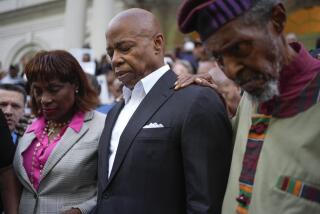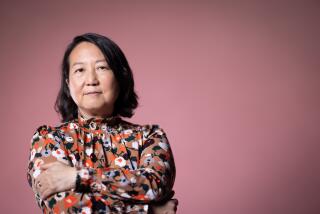Boycott Puts Korean Stores at Center of N.Y. Race Strife
- Share via
NEW YORK — A black youth with a freshly cut fade hairstyle unleashed a slur at an elderly Puerto Rican woman as she passed through the boycott line in front of a Korean-owned grocery store in Flatbush.
“You old whore,” he said in Spanish with a Caribbean accent.
The woman clutched the plastic-wrapped green cabbage she had just bought, looked down at the sidewalk and kept walking.
Hours later, a boycott organizer, drenched with rain, pleaded with reporters to look beyond the inflammatory scenes to the sentiment that has brought such ugliness to his neighborhood.
“This is not about African people against other peoples,” said the man who identified himself only as “T.W.,” an organizer of the Flatbush Frontline Collective, one of several groups forming the picket line. “The boycott is about lack of respect for African people, and how we have no economic control in our own neighborhoods.”
Surrounded by police, pickets, and television vans, two Korean-owned produce stores in Brooklyn--the Family Red Apple and Church Avenue Fruit--have fast become the most controversial grocers in the nation--the focus for racial epithets, stubborn resistance by their owners and acts of conscience by consumers.
For several months, the two shops and two juries deliberating in Brooklyn have been potential flash points in a city where racial tensions have been increasing.
The juries delivered verdicts at week’s end: One white youth was convicted of second-degree murder, another of a group of lesser charges, in the shooting death of a black teen-ager who walked with friends through a predominately white Brooklyn neighborhood last August.
Now the stores stand alone, for the time being, on the front lines of misunderstanding and anger.
The dispute began with what appeared to be a routine unpleasantry. On a Thursday in January, a 46-year-old Haitian woman, Giselaine Felissaint, walked into the Family Red Apple produce store on Church Avenue and took plantains costing $2 and limes worth $1 to the cashier.
According to one of the store’s owners, Bong Ok Jang, she paid only $2. When the cashier asked for the difference, the woman allegedly picked up a pepper and threw it at the cashier. The cashier threw back another pepper.
Store employees said Felissaint was ordered to leave. She fell to the floor, and other customers in the store told her to remain there until police arrived, employees said. She was taken to a local hospital, treated and released.
Felissaint’s lawyer tells a different story--that the store’s employees accused her of stealing and ordered her to open her bag. Her lawyer claimed that when the woman refused, two employees beat her. She has filed a $6-million lawsuit against the store’s owners.
Bong Jae Jang, a co-owner of the store with his brother Bong Ok, was arrested and charged with third-degree assault. His case is scheduled to be heard later this month.
Shortly after the incident, people in the community joined with the customer in calling for the store to be closed. Flyers were circulated on the streets, and a picket line began. Church Avenue Fruit was brought into the dispute when protesters claimed that a Red Apple worker who participated in the alleged beating took refuge there.
The boycott gained momentum and notoriety when Sonny Carson, a former Flatbush resident and highly visible activist, became involved. Carson said he was invited by some of the pickets because he took part in a boycott of Korean stores in Brooklyn’s Bedford-Stuyvesant section in 1988.
“There have been times when it looked like we would close,” said Bong Ok Jang, who has seen his business plummet from a gross of more than $1,500 a day to less than $10 a day during periods of the boycott.
This week, the store received donations from frequent customers and from a Korean grocers association in the Bronx.
“With the money, we have started restocking the shelves,” Jang said in Korean, as he cradled a bundle of bills.
The boycott has stoked what were simmering, long-felt tensions between Korean merchants and their black customers.
Many of the Korean grocers, who ventured into racially-mixed neighborhoods to pursue a long-cherished dream of economic ascent, have found that they have bought their way into a caldron of local rivalries and tensions.
Jang and his brother Bong Ok came to New York from Seoul in 1985 and worked in other Korean-owned grocery stores until they earned enough to buy their store two years ago. Since then, both owners have put in 14-hour days, waking early to buy produce and keeping the store open around the clock. The pattern of their entrepreneurship is common to many other Korean-Americans.
“This area is made up of mostly immigrants,” Jong Hyon Chai, the manager of a produce stand down the block from the pickets, said in Korean. “The slurs, the curses, the bad words, you always hear them on the street. Live here for a while, pick them up, and you start using them yourself.”
It is here, amid the fray that the demonstrators have expressed deeply felt affronts.
“Can you imagine how it felt to be a black man shortchanged by a Korean cashier,” said a boycott organizer in front of Brooklyn’s Erasmus Hall High School, where protesters met to discuss strategy.
“Standing there at the front of the line, with a shop-full of disbelieving eyes on me. There was not a thing I could say to make her believe I was telling the truth. Nothing would wash me that day I gave the Korean woman a $10 bill.”
The attending humiliation, the helplessness to contest such slights and the frustration that comes when blacks see Korean immigrants defy expectations by building prosperous businesses in low-income neighborhoods are a good part of what has fomented the anger.
The grocery store boycott has posed a major challenge for David N. Dinkins, New York’s first black mayor, who has searched for ways to bring a politically palatable end to the picketing.
Dinkins and his advisers are convinced that the boycott has no single leadership, which has hampered efforts to settle the dispute.
City officials say some of the rhetoric employed early on by the pickets was aimed at Korean merchants in general and that the attacks were toned down when the media began scrutinizing the dispute.
“There is no leader of that group, there is no single person,” Dinkins said in an interview. “What we’ve been doing is trying to resolve (the boycott) by meeting with the people who are out there. . . .”
Dinkins has said he believes progress is being made toward ending the boycott. He hopes that conciliatory voices on both sides will soon prevail.
One such voice, Monona Yin, co-chairperson for the Committee Against Anti-Asian Violence, said “the struggle in Flatbush . . . is what happens when you take out government money directed to the lower-income classes and force them to live next to one another on the edge of survival.
“It kills me to see ourselves pitted like this against African-Americans. It’s frustrating that they see us as enemies; it makes me even sadder when I realize that we are in a situation that has not been of our own making.”
Some of the black protesters also bemoan the hatred.
“We can bring out the humanity in each other, or we can bring out the damn devil,” said one who has walked the picket line on Church Avenue.
In 1986 in Los Angeles, four Korean merchants were shot to death during separate robberies by blacks. Responding to the concern of Korean business owners, the county established a mediating group called the Black-Korean Alliance to defuse disputes. The action came after anger and recriminations over the incidents had abated.
No such agency exists in New York. But community representatives and city officials met recently in a fourth-floor classroom at Nazareth Regional High School in Brooklyn to air grievances.
Some black speakers complained that Korean merchants often overreact when youngsters shoplift fruit. The speakers accused some merchants of thumbing scales to raise produce prices and displaying a suspicious and belligerent “attitude.”
Another speaker complained that when Korean merchants open stores, they often fail to confer with existing community boards, or they form their own merchant associations in spite of the presence of umbrella organizations representing the other area businesses.
“Your problems are no different than merchants who are Jewish, Italian or black,” he lectured, as a row of Korean grocers, dressed in sneakers and jeans, sat silently in the back of the room and listened to a translator.
Jinsoo Kim, an anti-Asian violence committee member, said that “when there has been an economic problem or social crisis, Asians have become a very easy target to scapegoat.”
“Look at the situation from some of the Korean merchants’ point of view,” she said. “During the course of several years, a merchant may have experienced thousands of cases of shoplifting. Many also will have personal experiences with armed robbery. In that kind of situation, a merchant will look at any customer who comes through the door as a possible shoplifter or possible burglar.”
Such a climate of suspicion can provide a fertile breeding ground for disputes.
Back on Church Avenue, the number of shoppers increased this week, including an Erasmus Hall High School history teacher who arrived with his class. But both the pickets and the shopkeepers were holding firm.
More to Read
Sign up for Essential California
The most important California stories and recommendations in your inbox every morning.
You may occasionally receive promotional content from the Los Angeles Times.










